There’s something timeless about a tree with yellow flowers — as if nature poured sunlight onto the earth in bloom form. These golden trees are not only beautiful but also bring warmth, joy, and brightness to any landscape. From tropical giants to delicate ornamentals, here are 18 stunning trees with yellow flowers that can turn any garden into a paradise of sunshine.
18 Stunning tree with yellow flowers Around the World
1. Golden Shower Tree (Cassia fistula)

Native region: South and Southeast Asia
Height: 30–40 feet
The Golden Shower Tree is perhaps the most famous yellow-flowering tree in the tropics. Its long, cascading clusters of bright golden blooms hang like natural chandeliers, earning it the nickname “Ratchaphruek” in Thailand.
Blooming in late spring, the tree becomes completely covered in golden blossoms before new leaves appear. It thrives in warm, sunny regions and is often planted along streets or temple grounds for its symbolic meaning of purity and renewal.
2. Yellow Tabebuia (Tabebuia chrysotricha)
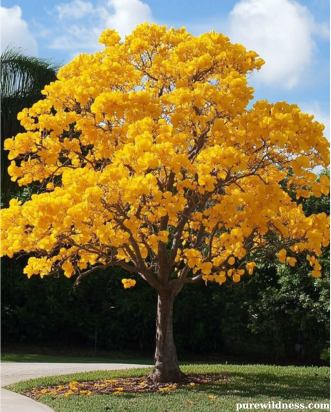
Native region: Central and South America
Height: 20–30 feet
Known as the Golden Trumpet Tree, this beauty puts on a spectacular show every spring. Its trumpet-shaped flowers create a carpet of yellow once they fall.
The tree prefers full sun and well-drained soil, making it a perfect ornamental choice for driveways or front yards. It’s drought-tolerant and attracts bees, hummingbirds, and butterflies.
3. Yellow Elder (Tecoma stans): A Stunning tree with yellow flowers
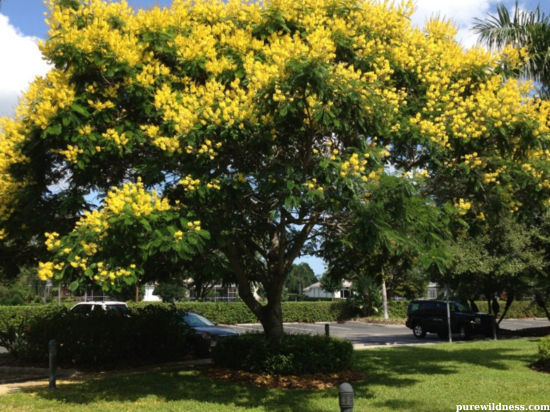
Native region: The Americas (Texas to Argentina)
Height: 10–25 feet
The Yellow Elder is a fast-growing, semi-evergreen tree famous for its bell-shaped golden blooms that appear almost all year in warm climates. It’s low-maintenance, thrives in poor soil, and is beloved by pollinators. Many gardeners use it as a hedge or accent tree because of its long-lasting color and resilience to heat.
4. Golden Wattle (Acacia pycnantha)

Native region: Australia
Height: 15–25 feet
Australia’s national floral emblem, the Golden Wattle, bursts into masses of fluffy yellow balls in late winter. The fragrance is soft and sweet, filling the air with spring energy. Its delicate green leaves contrast beautifully with the golden blooms, making it a popular garden and park tree. It also symbolizes unity and resilience — key traits of the Australian spirit.
5. Silk Cotton Tree (Cochlospermum religiosum)
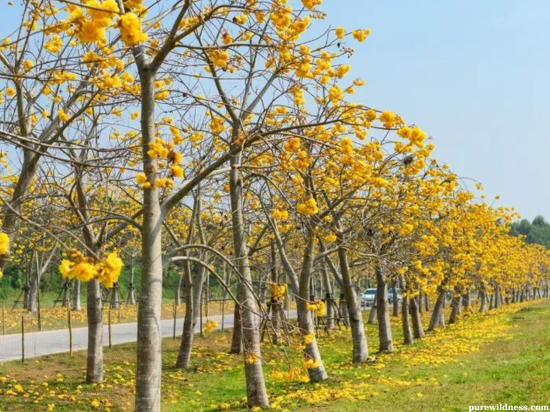
Native region: South Asia
Height: 25–40 feet
Native to South and Southeast Asia, the Silk Cotton Tree stands out for its dramatic spring display. Reaching up to 40 feet tall, it drops all its leaves before flowering, leaving bare branches covered in large, silky yellow blooms. Each blossom has five thick petals with a waxy texture and a rich golden tone, glowing intensely under the sun.
The trunk is gray-brown with rough bark, and after flowering, the tree forms oval pods filled with soft cotton-like fibers. In India and Sri Lanka, it’s often planted near temples, symbolizing spiritual clarity and renewal. When in full bloom, it looks like a golden torch against the dry-season landscape — a truly breathtaking tree with yellow flowers.
6. Yellow Flame Tree (Peltophorum pterocarpum)
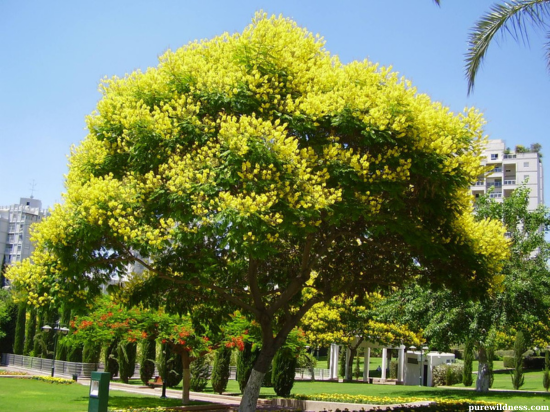
Native region: Tropical Asia and Africa
Height: 40–50 feet
Native to tropical Asia and Africa, the Yellow Flame Tree can reach 50 feet tall, forming a broad umbrella-shaped canopy. Its fern-like leaves give it a soft, feathery look, while clusters of bright yellow flowers bloom in dense bunches at branch ends. Each flower is about one inch wide with slightly ruffled edges, creating the illusion of flickering flames — the reason for its name.
The trunk is dark and rough, contrasting beautifully with the vivid blossoms. After flowering, long, flat seed pods hang gracefully from the branches. Commonly planted along avenues and in parks, it provides both brilliant color and cool shade. This tree with yellow flowers thrives in full sun and coastal regions, where it paints the skyline gold every summer.
7. Buttercup Tree (Cochlospermum vitifolium)
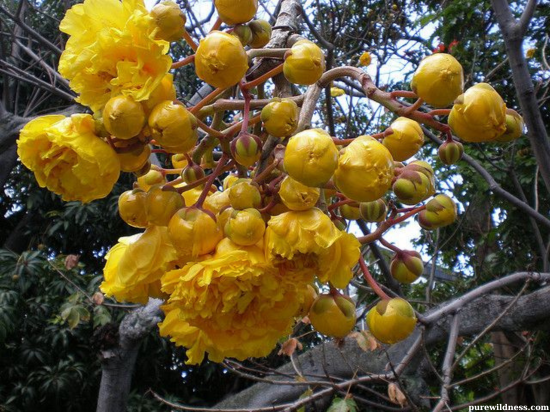
Native region: Central and South America
Height: 20–30 feet
The Buttercup Tree is native to Central and South America and grows up to 30 feet tall. It’s known for its silky, deep-yellow flowers that resemble oversized buttercups. Blooming at the end of the dry season, the flowers appear before new leaves sprout, creating a striking golden silhouette. Each bloom has soft, rounded petals with a delicate texture and a glossy sheen.
The bark is light gray, and the trunk often twists slightly with age. When the flowers fall, they form a brilliant carpet around the base. This drought-tolerant tree with yellow flowers is often used in tropical landscaping because it demands little care yet transforms a space with bold, radiant color.
8. Golden Chain Tree (Laburnum anagyroides)
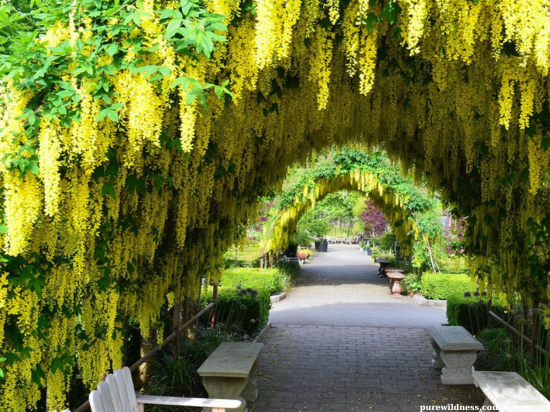
Native region: Southern Europe
Height: 15–25 feet
Originating in southern Europe, the Golden Chain Tree is a graceful ornamental that grows 15–25 feet tall. Its signature feature is the long, pendulous clusters of yellow blossoms that hang like golden waterfalls in late spring. Each chain can reach 10–20 inches long, made up of hundreds of small, pea-like flowers. The foliage is bright green and trifoliate, providing a soft backdrop to the glowing blooms.
The bark is smooth and gray, adding elegance even when not in bloom. This tree with yellow flowers thrives in cooler climates with partial sun and well-drained soil. When planted in rows, it forms enchanting tunnels of gold that resemble living chandeliers in the garden.
9. Japanese Golden Rain Tree (Koelreuteria paniculata)
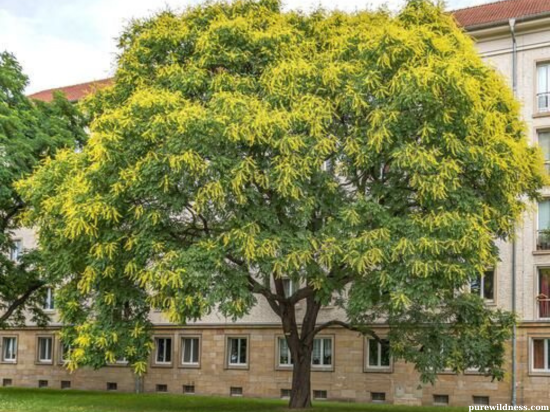
Native region: East Asia
Height: 25–40 feet
The Golden Rain Tree is a medium-sized ornamental native to East Asia, reaching 30–40 feet tall. In midsummer, it produces masses of small yellow flowers in large pyramid-shaped clusters, brightening up city streets and gardens alike. The tree’s bark is gray and slightly ridged, and its leaves are compound with serrated edges that turn golden-orange in fall. After flowering, papery, lantern-like seed pods appear, transitioning from green to bronze, extending the tree’s appeal into autumn.
This hardy tree with yellow flowers tolerates pollution and poor soil, making it ideal for urban landscapes. Its year-round color changes — yellow blooms, golden foliage, and bronze pods — make it a constant highlight in any environment.
10. Golden Champak (Michelia champaca)
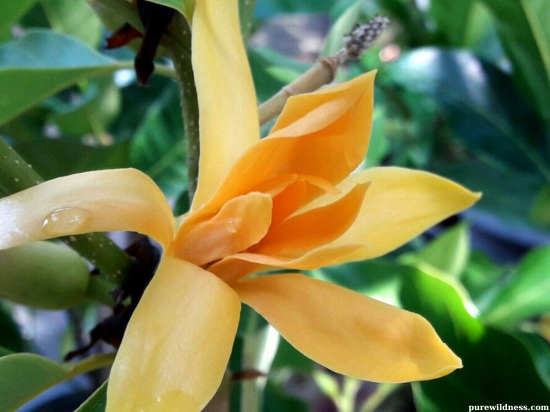
Native region: South and Southeast Asia
Height: 30–50 feet
The Golden Champak is a tropical evergreen tree known for its fragrant, yellow-orange blossoms. Native to South and Southeast Asia, it grows 30–50 feet tall with glossy dark-green leaves and a straight trunk. The flowers, with long, slender petals, release a sweet, exotic scent used in perfumes like Joy and Chanel No. 5. Blooming year-round in warm climates, the tree becomes a golden beacon near temples and gardens.
Its wood is also valued for carving. This tree with yellow flowers combines visual beauty and intoxicating fragrance, representing spirituality, luxury, and peace. In the morning sunlight, its blossoms glow softly — a scent and sight impossible to forget.
11. Acacia dealbata (Silver Wattle)
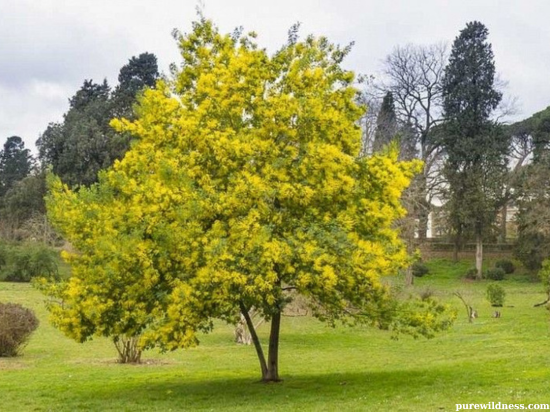
Native region: Australia
Height: 20–50 feet
Native to Australia, the Silver Wattle is a fast-growing tree with yellow flowers reaching 50 feet in height. Its feathery silver-green leaves shimmer beautifully in sunlight, while tiny, round, golden-yellow blossoms cover the branches in late winter. Each bloom is just a few millimeters wide but appears in dense clusters, forming a cloud of color.
The bark is smooth and gray, exuding a light, pleasant fragrance. This species is widely planted for soil stabilization and reforestation, as well as ornamental use. In full bloom, the Silver Wattle looks like a golden mist floating over silver leaves — elegant, airy, and full of life.
12. Amaltas Tree (Cassia fistula var. fistuloides)
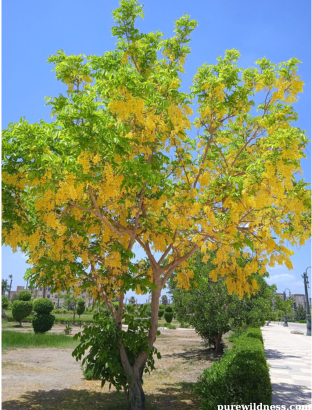
Native region: India and Southeast Asia
Height: 30–40 feet
Closely related to the Golden Shower, the Amaltas Tree is native to India and thrives in hot, dry conditions. Growing 30–40 feet tall, it bears long chains of deep-yellow flowers that droop elegantly from every branch. The petals are smooth and shiny, with a delicate fragrance that attracts bees.
The dark green compound leaves create a lovely contrast against the golden blooms. After flowering, cylindrical seed pods hang in clusters, adding texture. In Indian culture, Amaltas symbolizes prosperity and is used in herbal medicine. As a tree with yellow flowers, it is a national favorite, marking the arrival of summer and celebration.
13. Trumpetbush Tree (Tecoma garrocha)
Native region: South America
Height: 15–25 feet
Native to South America, the Trumpetbush Tree is a small, fast-growing species reaching up to 25 feet. It produces clusters of golden trumpet-shaped flowers with faint orange throats. The leaves are dark green and serrated, forming a dense crown that contrasts beautifully with the bright blooms.
Flowering occurs throughout the year in warm climates, often followed by slender seed pods. It attracts bees and butterflies and is loved for its low maintenance and vibrant look. This tree with yellow flowers brings a cheerful, tropical feel to gardens, often used as a decorative focal point or along pathways.
14. Frangipani (Plumeria lutea)
Native region: Pacific Islands and the Caribbean
Height: 10–25 feet
The Yellow Frangipani is a small tropical tree, 10–25 feet tall, known for its thick branches and stunningly fragrant flowers. Each bloom has five creamy-yellow petals with white edges, forming a pinwheel shape. The tree’s bark is gray and smooth, and the leaves are large, leathery, and deeply veined. It thrives in coastal or dry regions, tolerating heat and drought with ease.
When in bloom, the air fills with a sweet, tropical scent. Common in island landscapes, this tree with yellow flowers adds both beauty and aroma, making it a beloved choice for gardens, temples, and resorts.
15. Forsythia Tree (Forsythia × intermedia)
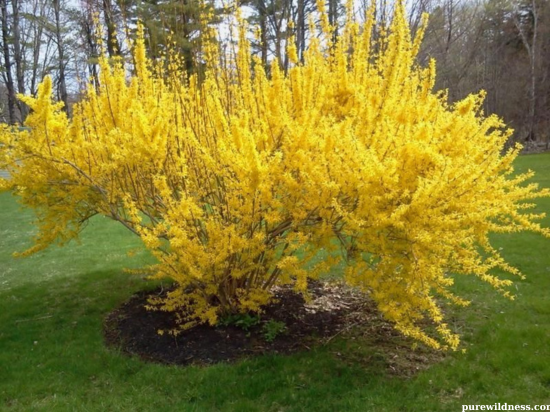
Native region: Eastern Asia
Height: 8–10 feet (technically a shrub)
Though technically a shrub, Forsythia can be trained as a small tree with yellow flowers. Native to East Asia, it grows about 8–10 feet tall and erupts with golden blossoms in early spring — often before the leaves appear. The flowers are star-shaped and densely packed along every branch, creating a glowing, fiery appearance.
The bark is smooth and light brown, and the green leaves emerge right after flowering, extending the plant’s seasonal appeal. Hardy and cold-resistant, Forsythia signals the end of winter, brightening gardens with its explosion of color when everything else is still asleep.
16. Yellow Poinciana (Caesalpinia ferrea)
Native region: Brazil
Height: 25–35 feet
Also known as the Brazilian Ironwood, this tree with yellow flowers grows 25–35 feet tall and is prized for both beauty and resilience. The bark peels naturally in patches, revealing gray, cream, and brown tones that create a marbled texture. Its yellow blossoms are small but dense, often streaked with red veins. The fine, fern-like leaves add elegance, turning bronze before dropping.
Native to Brazil, it thrives in tropical and urban conditions, tolerating drought and pollution. When in bloom, the Yellow Poinciana stands out as a symbol of strength, color, and tropical sophistication.
17. Golden Trumpet Vine Tree (Allamanda cathartica)
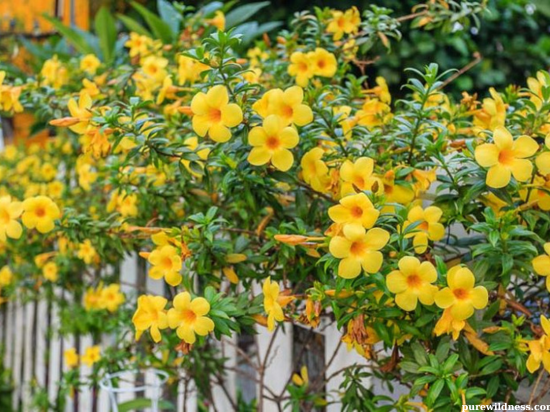
Native region: South America
Height: 10–15 feet (when trained as a tree)
Normally a climbing vine, the Golden Trumpet can be pruned into a compact tree with yellow flowers. Growing up to 15 feet tall, it blooms profusely with large, trumpet-shaped flowers in a bright, buttery yellow shade. The petals are thick and glossy, and the dark-green leaves form dense clusters that highlight the blossoms.
It flowers nearly all year in tropical climates, especially near the coast. The plant loves full sun and warm temperatures. Used decoratively near patios or fences, the Golden Trumpet adds a luxurious tropical touch with constant color and lush foliage.
18. Cassia javanica (Java Cassia)
Native region: Southeast Asia
Height: 30–40 feet
Native to Southeast Asia, the Java Cassia is a medium-sized tree with yellow flowers that also carries shades of pink and white. Growing 30–40 feet tall, it bursts into multicolored clusters in spring, creating an unforgettable gradient effect. The leaves are bright green and feathery, and the bark is smooth with a light gray hue. As the season progresses, the blooms shift from yellow to blush pink before falling to form a soft carpet below. The tree thrives in warm, humid climates and is a favorite in public parks. Elegant, colorful, and long-blooming — it’s nature’s confetti in full form.
Why Plant a Tree with Yellow Flowers?
Planting a Tree with yellow flowers adds more than color — it brings emotional warmth, attracts wildlife, and symbolizes happiness. Yellow trees look stunning along roads, in gardens, or near patios, blending perfectly with green landscapes.
They also improve air quality, offer shade, and support biodiversity by inviting pollinators like bees and hummingbirds.
🌿 Growing Tips for Yellow Flowering Trees
- Sunlight: Most yellow-flowering trees need 6–8 hours of direct sun.
- Soil: Choose well-drained soil rich in organic matter.
- Water: Moderate watering; avoid over-saturation.
- Pruning: Trim after flowering to shape and remove weak branches.
- Fertilizing: Use a balanced fertilizer during growing season for vibrant blooms.
🌼 Final Thoughts
Whether you live in a tropical paradise or a temperate suburb, there’s a trees with yellow flowers perfect for your space. These golden blooms remind us of sunshine, joy, and the beauty of life itself. Plant one — and let your garden shine all year long.

